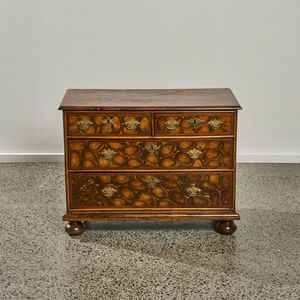William & Mary Oyster Veneer Chest, Late 17th Century
A William and Mary oyster veneer chest, C. 1690, England. A late 17th century English William and Mary laburnum oyster veneered chest of drawers of small proportions. Top drawer when pulled out reveals a secret drawer. The oyster veneer covers all four sides. Later brass handles. Height 65 cm, width 84.5 cm, depth 44 cm
You must be a subscriber, and be logged in to view price and dealer details.
Subscribe Now to view actual auction price for this item
When you subscribe, you have the option of setting the currency in which to display prices to $Au, $US, $NZ or Stg.
This item has been sold, and the description, image and price are for reference purposes only.
- Veneers - Veneers are thin sheets of well-figured timber that are glued under pressure to the surface of a cheaper timber for decorative effect, and then used in the making of carcase furniture.
Early veneers were saw-cut so were relatively thick, (up to 2 mm) but is was realised that saw cutting was wasteful, as timber to the equivilent of the thickness of the saw was lot on each cut.
A more efficient method was devised to slice the timber, either horizontally with a knife, or in a rotary lathe.
Flame veneer, commonly found in mahogany or cedar furniture, is cut from the junction of the branches and main trunk. So-called fiddleback veneers, where the grain is crossed by a series of pronounced darker lines, is usually cut from the outer sections of the tree trunk.
During the 17th and 18th centuries, and in much of the walnut marquetry furniture made during the latter part of the 19th century, the veneer was laid in quarters, each of the same grain, so that one half of the surface was the mirror image of the other.
The use of veneer allows many other decorative effects to be employed, including stringing, feather banding, cross banding, and inlaid decorative panels in the piece. The carcase over which veneer is laid is usually of cheaper timber such as pine, oak or, sometimes in Australia during the first half of the 19th century, red cedar.
The important thing to remember about veneers is that prior to about 1850 they were cut by hand, and were consequently quite thick - ranging up to about 2mm deep.
From the mid-19th century veneers were cut by machines and were almost wafer-thin. This is a critical point when trying to judge the approximate age of veneered furniture. - Oyster Veneer - "Oyster veneer" is a method of veneering occasionally used on antique furniture pieces. It refers to the use of thin, delicate sheets of wood that were cut from the growth rings of a tree to create a decorative pattern that resembles the texture and appearance of an oyster shell.
To create oyster veneer, the woodworker would carefully cut slices of the wood at a slight angle to the grain, so that the annual rings would be visible on the surface of the veneer. The resulting pattern looks similar to the swirling, irregular lines on the surface of an oyster shell, which is where the name comes from.
Oyster veneer was used to embellish high-end antique furniture pieces, such as cabinets, desks, and tables during the 18th and 19th centuries. - Laburnum - Native to Europe and the United States, Laburnum timber is used as inlay, marquetry and oyster veneer on furniture pieces from the 17th century. It has a beautiful, rich golden colour and interesting grain patterns. It can also be used in small turned items, such as knobs or handles, where its density and hardness can be an advantage. Laburnum is not commonly used in furniture construction due to its tendency to warp and split when exposed to changes in temperature and humidity. It is also a relatively hard and dense wood, which makes it difficult to work with hand tools.
- Proportions - Essentially, the size of the various parts of a piece of furniture in relation to the whole. Ideally, the proportions should be pleasing to the eye appearing neither top-heavy nor unbalanced and convenient for ordinary use.
This item has been included into following indexes:
